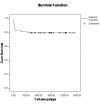Aortic valve replacement in octogenarians
- PMID: 17629905
- PMCID: PMC1947977
- DOI: 10.1186/1749-8090-2-33
Aortic valve replacement in octogenarians
Abstract
Background and aims: As our population ages and life expectancy increases the number of people aged over 80 and more referred for cardiac surgery is growing. This study sought to identify the outcome of aortic valve replacement (AVR) in octogenarians.
Methods: 68 patients aged 80 years or more underwent AVR at the Freeman Hospital, between April 2001 and April 2004. A retrospective review of the notes and outcomes from the patients' GP and the NHS strategic tracking service was performed. 54% (37) underwent isolated AVR whilst 46% (31) underwent combined AVR and CABG.
Results: Follow up was 100% complete. The mean age was 83.1 +/- s.d. 2.9 years, a mean gradient of 83 +/- s.d. 31 mmHg and mean AVA of 0.56 cm2. The mean additive EuroSCORE was 8.6 +/- s.d. 1.2, the logistic EuroSCORE mean 12.0 +/- s.d. 5.9. In hospital 30 day mortality was 13 %. Survival was 80% at 1 year and 78% at 2 years. Median follow up was for 712 days. Stepwise logistic regression identified chronic obstructive airways disease as an independent predictor of mortality (p < 0.05). Survival was not adversely affected by the addition of coronary artery bypass grafts to aortic valve replacement, the presence of peripheral vascular disease, hypertension or diabetes. In this study duration of cross clamp or bypass time were not found to reach significance as independent predictors of mortality.
Conclusion: Our study demonstrates that the operative mortality for AVR in the over eighties is good, whilst the mid to long term outcome is excellent There is a very low attrition rate with those undergoing the procedure living as long than their age matched population. This study confirms AVR is a safe, acceptable treatment for octogenarians with excellent mid term outcomes.
Figures
References
-
- Asimakopoulos G, Edwards MB, Taylor KM. Aortic valve replacement in patients 80 years of age and older: survival and cause of death based on 1100 cases: collective results form the UK valve registry. Circulation. 1997;96:3403–8. - PubMed
MeSH terms
LinkOut - more resources
Full Text Sources
Research Materials
Miscellaneous


